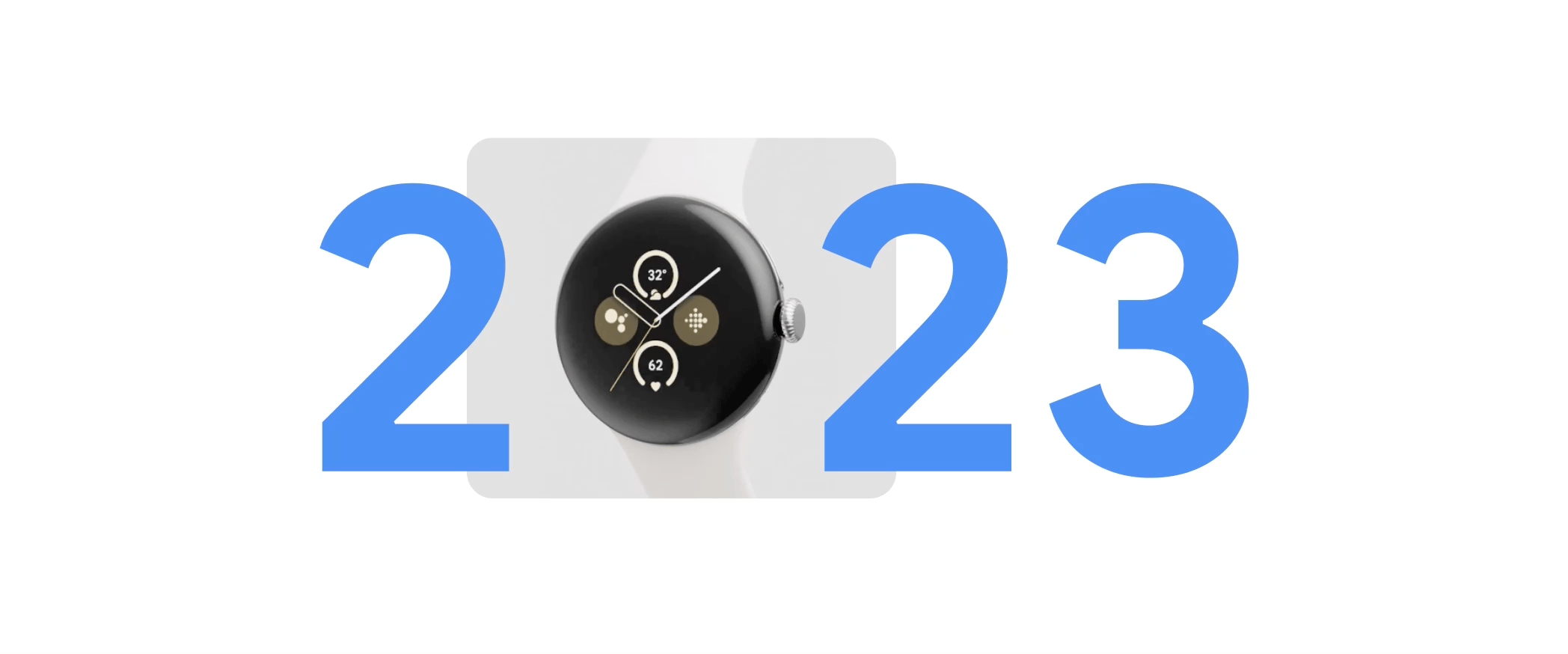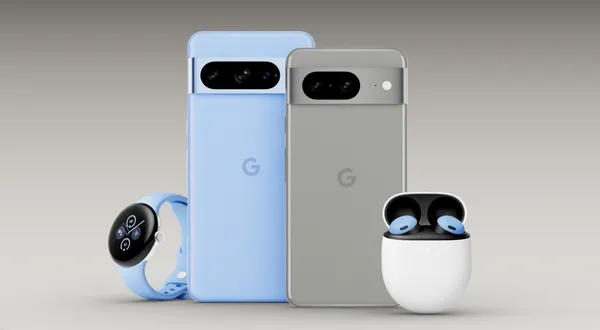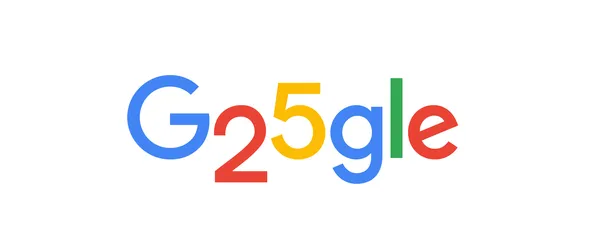23 of our biggest moments in 2023

The year is just about wrapped, and we’re all ready to say goodbye to 2023 and hello to 2024. But before we get excited about what the new year will bring, let’s take a look back at 23 of our biggest product moments from 2023!
1. We welcomed the Gemini era
Gemini is our largest and most capable AI model yet and the next step toward making AI more helpful for everyone. It’s built to be multimodal, meaning it can generalize and seamlessly understand, operate across and combine different kinds of information, including text, audio, video and code. Gemini is also our most flexible model yet, efficiently built to run on everything from mobile phones to data centers with three sizes: Ultra, Pro and Nano. You can already use Gemini Pro in Bard and Gemini Nano in Pixel 8 Pro, and we just released the Gemini API for developers and Google Cloud customers last week.
2. Bard entered the chat
We debuted Bard, an interactive experiment that lets you collaborate with generative AI. Bard has expanded considerably since its launch: Bard learned how to code, added visual capabilities and expanded globally and connected to more Google apps and services. Oh, and soon Bard and Assistant will start working together!
3. We experimented with generative AI in Search
Search Generative Experience (SGE) is a Search Labs experiment that uses generative AI to help you understand topics in faster, easier ways and uncover new insights. You can get AI-powered overviews that bring together the most helpful and relevant information available for your search, with links to learn more. This year, we also added the ability to create images with generative AI.
4. Android kept the updates coming
Android 14 dropped, and with it came tons of customization updates, like new options and styles for shortcuts, generative AI wallpapers, color palettes, fonts, widgets and more. Android 14 also includes new health, security and data upgrades and expanded features for low-vision and hard-of-hearing users. And we launched Magic Compose in beta, a Google Messages generative AI tool that helps you find exactly the right words.
5. We introduced powerful new Pixel phones
The Pixel Fold, our first foldable phone, made its big debut in 2023. Meanwhile, we continued our A-series with Pixel 7a, and we launched Pixel 8 and Pixel 8 Pro. Our latest Pixel series is powered by Google Tensor G3 and sports a new batch of pro-level camera features. The Pixel 8 Pro is also the first smartphone with AI built in, now running Gemini Nano to power new features such as Summarize in the Recorder app.

6. The Pixel family grew
There’s more to the Pixel family than phones: This year also marked the debut of the brand new Pixel Tablet and its slick docking station. And Pixel Buds Pro got an upgrade with clearer voice calling, suggestions for hearing wellness and more.
7. Plus, there was Chromebook Plus
We also launched Chromebook Plus, a powerful, AI-driven device with features and tools specifically designed for any consumer looking to step up their laptop game. Chromebook Plus comes with the best-in-class security and access to all the apps users know and love, and twice the power, speed, memory and storage as standard Chromebooks.
8. We welcomed wearable updates
We introduced the Google Pixel Watch 2, a more powerful smartwatch with improved health insights and new safety features for peace of mind, and the Fitbit Charge 6, which comes with real-time heart rate tracking that connects to compatible exercise equipment plus seven days of battery life. And there were two major software upgrades for wearables: The new Fitbit app made its way to the Google Pixel Watch and Fitbit devices, and a new version of Wear OS brought new productivity and entertainment features to Google Pixel Watch and other Wear OS-enabled devices.
9. We launched new ways to track your health
These new products came with new ways to monitor your wellness. In addition to our most accurate heart-rate tracking system for Google Pixel Watch as well as for Fitbit Charge 6, we also built new tools like fall detection and oxygen saturation (SpO2) tracking for the Google Pixel Watch.
10. We helped you be prepared
We launched extreme heat alerts to help people find information about heat waves and expanded flood forecasting to more regions. And the new Pollen API gave developers using Google Maps Platform the ability to add information on changing allergens in a given area.
11. Google Maps got even more immersive
This year saw plenty of big updates for Google Maps, like the start of the Immersive View for routes rollout, which enables you to visually preview an entire trip — bike lanes, intersections, where to park and more — before you even step out the door. Maps also helped navigate the great outdoors with new features for exploring national parks. Plus we expanded fuel-efficient routing to more places to help combat CO2 emissions.
12. We focused on photo features
We launched some AI editing tools this year: Magic Editor, which helps you easily make complex edits like repositioning the subject of your photo, and Best Take for Pixel 8 and Pixel 8 Pro, which uses a series of similar photos taken close together to help you automatically create a blended image with everyone’s best expression. To make taking those group photos even easier, we announced palm gesture selfies — a feature that enables you to trigger the shutter with a wave of the hand. And to help you better enjoy and surface your photos after the fact, we also launched a new Memories view for Google Photos.
13. RCS got a little richer
Rich communication standard, or RCS, is the modern texting standard around the world. We’ve been working to help carriers and smartphone makers adopt this protocol, and it’s paying off: RCS hit 1 billion users in Google Messages this year! To celebrate, we launched tons of new features that support RCS and make Messages even better for Android users — for example, we added end-to-end encryption for group messages and Voice Moods (beta) to accompany your voice messages with fun visual effects..
14. Workspace worked hard
This year was full of Google Workspace launches. To name just a few: We expanded the AI-powered Smart Compose feature to Google Chat, helping you quickly craft a response in Chat, offering contextually aware suggestions that help reduce spelling and grammar errors. New building blocks for Workspace made adding more info like additional files or Google Calendar entries just an @ away. And our new meeting scheduler in Gmail made it easier for you to find time to meet directly from your inbox.
15. Duet AI for Google Workspace helped you work
Duet AI in Google Workspace is an AI-powered collaborator that can act as a coach, thought partner, source of inspiration and productivity booster, that became generally available in August. Today, customers and trusted testers are using it across the Workspace tools they’ve known and loved for years. For example: Duet AI in Slides can help you easily generate images for your presentations with simple text-based prompts. Duet AI in Sheets can automatically create custom plans for tasks, projects or any activity that you want to track or manage. Duet AI in Gmail can help you write or refine emails. Duet AI in Meet helps you generate unique backgrounds for your video calls, and Duet AI in Docs can help you write and refine whatever it is you’re drafting.
16. And we expanded Duet AI in Google Cloud
Duet AI isn’t just for Workspace — we also expanded our AI-powered collaborator across Google Cloud, providing AI assistance across a wide range of Google Cloud products and services to serve more cloud users, including developers, operators, data practitioners, and cybersecurity professionals. For example: Duet AI for Developers, now generally available, helps users increase software development and delivery velocity with a range of helpful features, including AI code assistance, natural language chat, AI-assisted troubleshooting, AI-powered smart actions and reduced context-switching and expedited learning.
17. Passkeys boosted security
We stepped up security with passkeys, a simpler and more secure way to sign into your accounts online. With passkeys, you use a fingerprint, face scan or pin to unlock your device and sign into your accounts — without the need for a password. Passkeys rely on a type of technology called public key cryptography that makes them more secure than passwords — which is why we made them even more accessible by offering them by default across personal Google Accounts.
18. We gave virtual try-ons a try
Google introduced a new AI-powered tool that lets you virtually try on clothing using a diverse set of 80 real models in a range of sizes — from XXS to 4XL — as well as with different skin tones, body shapes, ethnicities and hair types.
19. YouTube added new AI tools for creators and artists
At Made on YouTube 2023, we announced AI features that will enable people to push the bounds of creative expression including AI-generated backgrounds for Shorts with Dream Screen and a new mobile video production app called YouTube Create. And we launched experimental music AI tools, like Dream Track for Shorts, which allows a small cohort of creators the opportunity to create up to 30 second unique Shorts soundtracks featuring the AI-generated voice of the participating artists of their choice with just a simple prompt!
20. We spent time in the lab
Earlier this year we launched Labs, a home for Google’s experimental AI tools and technologies. When you sign up for Labs, you can test out projects across Search, Workspace and more, and give feedback directly to the teams who built them. One of our Labs offerings is NotebookLM, our endeavor to reimagine what note-taking software might look like if you designed it from scratch knowing that you would have a powerful AI model at its core.
21. Chrome got a little shinier
We released a whole new look for the Chrome Web Store as well as a handful of address bar updates. And when our favorite browser turned 15 this year, we announced new features — like refreshed icons, new color palettes and AI-powered extensions — to celebrate.
22. We helped you source your facts
We launched new and updated current tools to help you fact check information you see online. Fact Check Explorer, which is used by fact checkers and journalists around the world, added an image-checking feature so now you can see if other fact checkers have verified it. And Search introduced About this image, which brings you information about an image’s web history, details on how websites use it as well as its metadata.
23. And the Search continued
2023 marked 25 years of Google Search! And we’re definitely not slowing down: Along with expanding Multisearch and introducing SGE, we added 33 new languages to Google Translate and more help with science and math. We also added upgraded insights on Google Flights to help you find the best price. Plus, Google Trends got a makeover.








